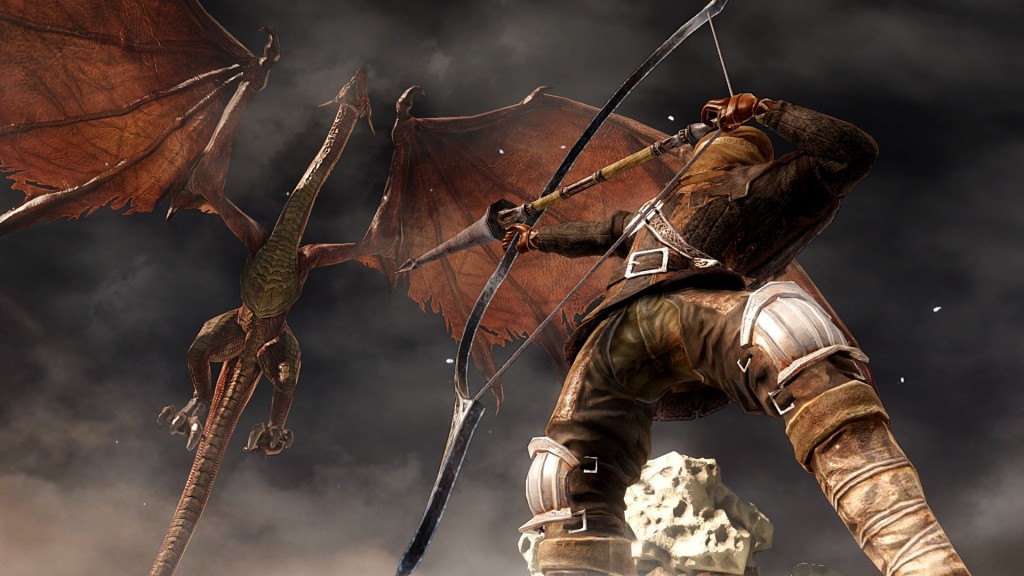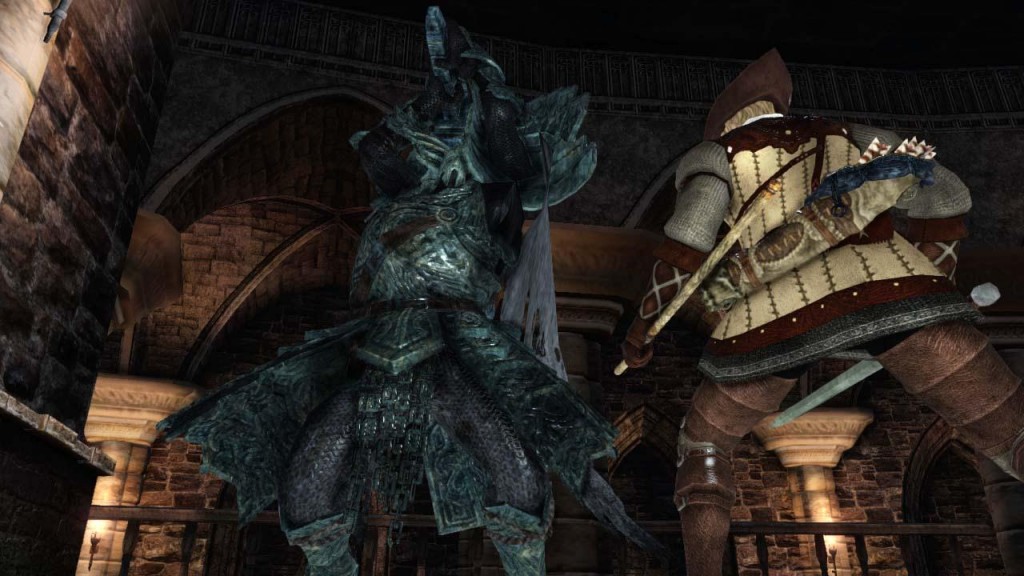Last updated on May 14, 2014
Dark Souls II is a strange, strange sequel. It tries to cull ideas from its predecessors, and yet mixes them in strange ways. Some lead to explosions of delightful mechanical interplay, and others fizzle out when you take a good hard look at them.
If it’s a refinement, then it does not seem to be a great refinement. The Bible uses a great deal of imagery referring to the process of “refining” a people in the blazes of life, only for them to survive or die (Zechariah 13:9):
“And I will bring the third part through the fire,
Refine them as silver is refined,
And test them as gold is tested.
They will call on My name,
And I will answer them;
I will say, ‘They are My people,’
And they will say, ‘The Lord is my God.’”
The imagery hits you precisely because there’s no great metaphorical imagery than a blacksmith’s primary focus. The metal must melt and refine; if it doesn’t, then it’s a worthless piece. You can’t craft it into much of anything. You know how people often talk about gold as if you could build things with it? Think again! Gold is one of the most fragile metals, and golden armor (as you often find in video games) literally provides zero protective help. So where does Dark Souls II land in this process? Does it survive, or does it fall?
In Dark Souls II’s case, the results are difficult to parse out without some frequent comparisons to its past. Overall, though, I can make a pretty fair argument that it’s a step backward.
I’m sure that I am late to the party, but my wait for the PC version definitely helped me obtain the best possible experience. Playing Dark Souls II at a smooth 60 FPS for the entire game, no slowdown at all, sounds a fair bit better than the sub-30 FPS numbers of both console ports. Even so, the game holds its own share of interesting quirks and, dare I say, flaws, so let’s get to it. I’m not going to describe WHAT Dark Souls is; you can find that information anywhere. Rather, I’m going to make a full comparison and criticism of the game relative to its peers.
Exploration
In the most basic sense, Dark Souls is really a simple game based on a simple premise. The difficulty arises not from actual dexterity and/or reflexes, but knowledge. I imagine that’s why everyone has their favorite in the series, and it’s usually the first one. Because so much is obscured, strange, and new, and since the game doesn’t bother to actively teach you, you figure things out as you go. If you’ve got a strange build, you may find boss X harder than boss Y, and that’s part of the fun for new players.
However, once you do have a general knowledge of how the game works, everything becomes very, very easy as long as you’re paying attention. That’s why Dark Souls becomes so easy after Ornstein and Smough – there’s really not much more they can throw at you after that point, and leveling up/equipment upgrades turn cheap and easy at the end. Since it’s an RPG, they can’t really balance it in the same way a strict combat-action game has to work, and so there’s always going to be a problem with the back end of Souls games. I’m just clearing the air here if you’re wondering why I give the other Souls games a pass on certain elements.
Every boss has a weakness, and you can figure it out once you’re familiar with everything. Then again, some people might not have access to an ultra greatsword due to stats. Experimentation is key, as is knowing your options. That goes for story and lore too, as it mostly doles out in cryptic dialogue, environmental clues, and item descriptions. You gotta work for your story and your understanding of this mysterious world.
So the basic tenet of Dark Souls consists in exploring in a number of ways – fine and dandy. Now, does Dark Souls II measure up? On a systems and rules-based level, it does exactlty what the previous game did. I think the central problem might be that the game’s actually too cryptic! Honestly, compared to the first game, where NPCs would clearly tell you where to go if prodded and item descriptions would also help, Dark Souls II frequently gave no indication on where to go.
On one level, that gives the player a degree of freedom to choose their own way (and, obviously, that choice has obvious ramifications for how hard you think the game will be!). On the other hand, you frequently find yourself at dead ends with literally zero observable evidence as to where to go but wandering around. Dark Souls gives you far more direction while not being cryptic for no reason; Dark Souls II, on the other hand, just does it to be annoying and to live up to a preconceived “reputation”. Apparently From Software doesn’t realize why they obscured knowledge in the first place.
Probably the most damning criticism I can level is that I can barely remember any of the locations except for the vaguest notions of where I went. Dark Souls and Demon’s Souls alike forced you, through constant carefulness, to know the ins and outs of every single section. Here, I just blitzed through, and since I could teleport out it didn’t really matter. A series of linear corridors and areas does not a great Souls game make!
Level Design
And that speaks to the bigger issue here: the level design.
First and foremost to the obvious issue – the level design isn’t as precise or tight as either Dark Souls or Demon’s Souls. Mostly this comes down to the newly accessible bonfire system, which allows you to teleport to ANY bonfire in the entire game as long as you use it once. From my count, there’s at least 3-4 times the number of bonfires that Dark Souls had in total, which means you will find constant break points for resting.
That sorta removes the tension from some sections, and they seem haphazardly placed in general. Because Dark Souls and Demon’s Souls placed such safe havens so far from each other, there was a real risk moving from one to the other. You could die or lose your souls as you plumbed the unknown. It was scary and exhilariting. Here, I found myself at the bonfire FAR too often for death to mean much of anything. Lack of consequences harms the Souls formula immensely.
Sometimes, you’ll see a few enemies before a new bonfire (Harvest Valley comes to mind), and other times you’ll go forever without any bonfire at all (Huntman’s Copse feels like this, even if it isn’t true). They hide some of them, but they’re quite easy to find all said. If you’ve gone fifteen minutes or so without finding it, just press the confirm button next to all the walls in the general vicinity. That’s a tedious way to find it, but it works.
The gating to restrict your path feels pretty laughable when a knee-high wall prevents your character from moving to a new area; why did the original Dark Souls never seem to have this problem? Clearly, the inconsistency in combining open world with linearity meant a lot of artificial gates to progress. That doesn’t mean it isn’t possible to do things out of order, just very difficult. From the beginning of the game, it’s possible to do Heide’s Tower of Blue or Forest of Giants (the latter being the actual beginner area). The pit areas require the Silvercat Ring, which costs a pretty astronomical 14000 souls, so unless you’re amazing at not dying, it will take you some time to do that sequence break.
The teleporting means that most levels and sections play out like extremely linear segments of obstacles and combat; you won’t find the labyrinthine connections of Dark Souls or the inter-level connectivity of Demon’s Souls via unlocking shortcuts. Secrets areas exist, but enough observation will lead you to a dead end rather than a neat new path. In Dark Souls II, you get to the end and then you teleport back to Majula, the hub area, for levels, equipment, and whatnot. None of this necessarily breaks the game, but you start seeing the pattern very early in the game and it never seems to break or try for something new. Admittedly, Dark Souls areas after obtaining the Lordvessel did the same thing, but at least you earned it!
By that point, you pretty much memorized the levels from both traversing them multiple times and dying again. Since the game forces a careful, measured approach, you really needed to take your time. In Dark Souls II, I honestly can’t remember how most of the game is structured since it’s one linear line. Scratch that: I don’t have to remember it because the game provides no incentive to remember, nor does it force you to remember.
I can totally see their intention in crafting the levels as many long paths: they wanted to mix the ideas of the previous two games together, so they tried to combine Metroid-style open world design with linear paths. Unfortunately, that makes each area feel very much like a game environment rather than a world ripe for exploration. Sometimes a mix of great game elements seem like they should work together, but that can come at the risk of nailing the overall “feel” of the game. So, strike one for the title – Dark Souls II melts a bit in the heat of the flame.


